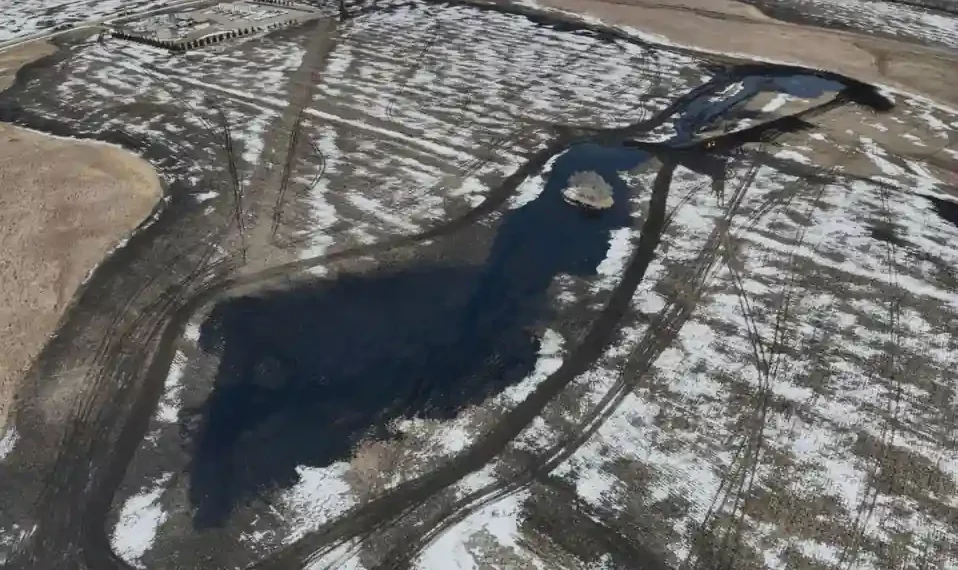Cleanup Efforts Underway After Keystone Oil Pipeline Spill in North Dakota
In a rural corner of North Dakota, cleanup crews have begun the delicate task of containing the aftermath of a significant oil spill from the Keystone pipeline. The rupture, which occurred early Tuesday morning, prompted a swift shutdown of the pipeline within two minutes of an employee hearing a mechanical bang. The cause of the rupture and the timeline for full restoration of the pipeline remain unclear.
An aerial photo released on Wednesday showed a black, pond-like pool of oil spreading across a partially snowy field, with tire tracks crossing through the area. Local farmer Myron Hammer reported smelling crude oil in the air, carried by the wind.
South Bow, the company managing the pipeline, has estimated the spill’s size at 3,500 barrels, or approximately 147,000 gallons of crude oil. Keystone’s entire pipeline system is currently shut down as a precaution, while the cause of the spill is under investigation.
As of now, the cause of the rupture remains unknown. South Bow is actively working to determine the origin of the spill and how long repairs will take. The rupture is significant, with experts noting that 3,500 barrels of crude oil equals the load of 16 tanker trucks. Paul Blackburn, policy analyst for Bold Alliance, pointed out that this isn’t an isolated event for the Keystone Pipeline, which has a troubling history of spills.
In fact, since 2017, Keystone’s system has spilled nearly 1.2 million gallons of oil, compared to just over 1,200 gallons from the Dakota Access pipeline. These figures underscore ongoing concerns about the pipeline’s reliability.
The Keystone Pipeline, stretching over 2,700 miles from Alberta, Canada, to Oklahoma and Texas, has faced its share of challenges. Built in 2010 at a cost of $5.2 billion, it is no stranger to criticism. The latest incident follows a similar rupture in Kansas in December 2022, which dumped 13,000 barrels of oil into a creek. Investigations attributed that rupture to a faulty weld, with long-term stress causing the pipe to crack.
Experts, including Ramanan Krishnamoorti from the University of Houston, explain that oil pipelines are susceptible to various stressors. These can include corrosive elements, temperature fluctuations, soil movements, and external pressures like construction and train activity. With such stressors, pipelines often face significant wear over time.
South Bow has begun deploying vacuum trucks to recover the spilled oil, and air quality monitoring is ongoing. The affected segment of the pipeline is isolated, and the company is assessing how to return the pipeline to service. Local landowner Myron Hammer, whose property lies near the spill, has reported minimal immediate impact beyond the strong smell of oil and the increased activity around his farm.
The spill site is located near Fort Ransom, a small, scenic town known for outdoor recreation. This incident marks another chapter in the ongoing debate about the safety and environmental risks of pipeline systems.
The company has expressed confidence that it is doing everything possible to address the situation, with crews working around the clock to contain and clean up the spill. However, questions about the pipeline’s safety record and the frequency of such incidents continue to raise concerns among environmental groups and landowners.
The shutdown of the pipeline could potentially affect gas prices in the Midwest, with ripple effects for diesel and jet fuel as refineries adjust to the loss of crude oil supply. Some experts warn that higher diesel prices could lead to increased costs for goods transported by truck, including groceries.
However, other industry analysts suggest that refineries likely have enough crude oil stockpiled to avoid any immediate price hikes. While gas prices have been rising for the past few weeks, the ongoing global trade situation could also influence prices in unpredictable ways.
As cleanup efforts continue, it’s clear that the Keystone Pipeline faces mounting scrutiny over its environmental impact and the frequency of spills. The future of the pipeline will depend on the results of ongoing investigations and the company’s ability to address these issues effectively. For now, residents and workers in the affected area will continue to deal with the aftermath, while questions about the long-term safety and reliability of the pipeline remain unanswered.
This article was rewritten by JournosNews.com based on verified reporting from trusted sources. The content has been independently reviewed, fact-checked, and edited for accuracy, neutrality, tone, and global readability in accordance with Google News and AdSense standards.
All opinions, quotes, or statements from contributors, experts, or sourced organizations do not necessarily reflect the views of JournosNews.com. JournosNews.com maintains full editorial independence from any external funders, sponsors, or organizations.
Stay informed with JournosNews.com — your trusted source for verified global reporting and in-depth analysis. Follow us on Google News, BlueSky, and X for real-time updates.














